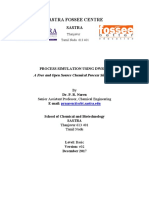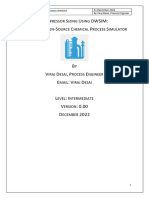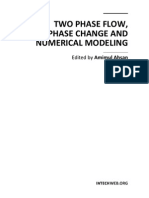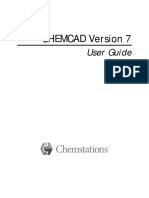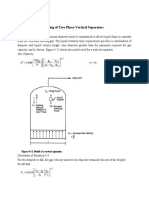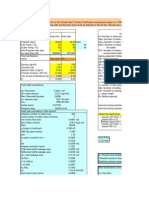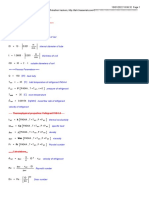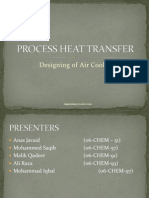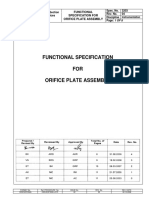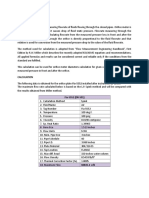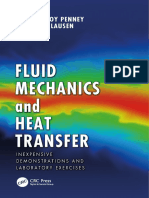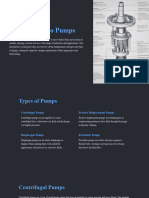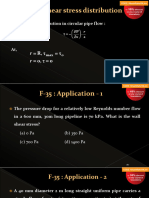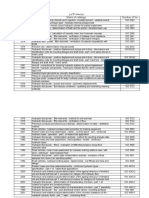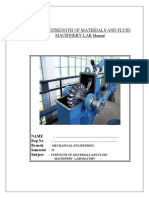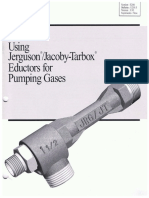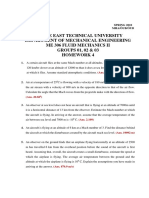SIZING OF ORIFICE USING DWSIM 29 January 2023
By Viraj Desai, Process Engineer
SIZING OF ORIFICE USING DWSIM:
A FREE AND OPEN-SOURCE CHEMICAL PROCESS SIMULATOR
BY
VIRAJ DESAI, PROCESS ENGINEER
EMAIL: VIRAJ DESAI
LEVEL: ADVANCED
VERSION: 0.00
JANUARY 2023
1
� SIZING OF ORIFICE USING DWSIM 29 January 2023
By Viraj Desai, Process Engineer
PREFACE
The manual “Sizing of Orifice Using DWSIM” present a set of “Sizing of Orifice Calculation Using
DWSIM” exercise using a free and open-source chemical process simulator “DWSIM” and can be
utilized to establish process simulation laboratory as part of undergraduate chemical engineering
degree or in allied degree curriculum. The problem statements are of intermediate level.
Prerequisite
• Must know about DWSIM UI/UX.
• Flow sheeting in DWSIM
• Selection of Thermodynamic Packages.
• Manipulating variables
• Orifice Sizing Fundamentals
• Basic Modules
Thanks
Viraj Desai
P.E. O&G
Disclaimer
All the exercises are strictly restricted to learning only and not meant to be used in real world
application.
2
� SIZING OF ORIFICE USING DWSIM 29 January 2023
By Viraj Desai, Process Engineer
PROCESS SIMULATION USING DWSIM: A FREE AND OPEN-SOURCE CHEMICAL
PROCESS SIMULATOR
PREAMBLE
DWSIM is an open-source CAPE-OPEN compliant chemical process simulator. It features a Graphical
User Interface (GUI), advanced thermodynamics calculations, reactions support and petroleum
characterization / hypothetical component generation tools. DWSIM can simulate steady-state,
vapor–liquid, vapor–liquid-liquid, solid–liquid and aqueous electrolyte equilibrium processes and has
built-in thermodynamic models and unit operations (https://en.wikipedia.org/wiki/DWSIM ). It is
available for Windows, Linux and Mac OS.
The objective of the course is to create awareness of the open-source process simulator “DWSIM”
among prospective graduates and practicing process engineers. The course will cover Intermediate
aspects of create flow sheet in DWSIM and simulation of simple Pressure changing module like pipe
segment, Compressor, etc.
Target Audience
• Junior Interns in Process Firms
• III / Final year B. Tech. Chemical Engineering students
• M. Tech. Chemical Engineering students
• Practicing Process Engineers
3
� SIZING OF ORIFICE USING DWSIM 29 January 2023
By Viraj Desai, Process Engineer
Table of Contents
1 Flow meters .................................................................................................................................... 6
1.1 Overview of Flow Meters ........................................................................................................ 6
1.2 Process Design Of Orifice Meter ............................................................................................. 6
2 Sizing of Orifice Calculation............................................................................................................. 8
3 Sizing of Orifice Using Korf Hydraulics .......................................................................................... 14
4 Cross-Checking in Python.............................................................................................................. 15
5 References .................................................................................................................................... 17
4
� SIZING OF ORIFICE USING DWSIM 29 January 2023
By Viraj Desai, Process Engineer
List of Figures
Figure 1 Various Tap Locations for Orifice Meter ................................................................................... 6
Figure 2 Header Stream Specs ................................................................................................................ 9
Figure 3 Pipe Segment block ................................................................................................................... 9
Figure 4 Inlet Pipe Segment Specs ........................................................................................................ 10
Figure 5 Outlet Pipe Segment Specs ..................................................................................................... 11
Figure 6 Orifice Plate ............................................................................................................................. 11
Figure 7 Orifice Plate Specs................................................................................................................... 12
Figure 8 Flow Sheet ............................................................................................................................... 13
Figure 9 Orifice Sizing in Korf Hydraulics .............................................................................................. 14
Figure 10 Orifice Sizing Results (dP taps) .............................................................................................. 14
Figure 11 Relation of Diameter of Orifice vs Pressure drop in Pipe ..................................................... 15
5
� Flow meters 29 January 2023
By Viraj Desai, Process Engineer
1 FLOW METERS
1.1 OVERVIEW OF FLOW METERS
A variety of fl ow meters are in use in chemical process industry. One category is the traditional
differential pressure (DP) type volumetric fl ow meters. In many applications, the volumetric fl ow
rate is of direct interest to the user. Because of its accuracy, simplicity, and relatively lower cost,
these fl ow meters are popular in the chemical industry. By multiplying the fl ow rate with the actual
density, mass fl ow rate can be obtained. Pitot tube, orifice meter, venturi meter and fl ow nozzles
fall under this category. Among these, orifice meter is by far the most popular in the industry.
Figure 1 Various Tap Locations for Orifice Meter
1.2 PROCESS DESIGN OF ORIFICE METER
Orifice meter is a widely used fl ow meter in chemical industry, compared to venturi meter and
rotameter.
Advantages of orifice meter are:
1. Fixed cost is less.
2. Easy to fabricate and install.
6
� Flow meters 29 January 2023
By Viraj Desai, Process Engineer
3. Occupies less space as compared to the venturi meter.
4. Provides more flexibility. Orifice plate can be easily replaced.
Disadvantages of orifice meter is higher power consumption and hence operating cost of orifice
meter is higher than the same of venturi meter and of rotameter.
There are total five standard locations of pressure taps (3 standard location are discussed in this
manual):
1. Corner taps: Static holes made in upstream and downstream flange. They are very close to
the orifice plate. With corner taps, it is possible to drill both static holes in the orifice plate
itself. Then entire orifice meter can be easily inserted in any flanged joint without drilling the
holes in pipe or flanges.
2. Flange taps: Static holes made at a distance 25.4 mm on upstream side and 25.4 mm on
downstream side.
3. Radius taps: Static holes located at a distance one pipe diameter on upstream side and 1/2
pipe diameter on downstream side. Radius taps are the best from practical standpoint of
view as it gives reasonably good pressure difference, compared to other taps except vena
contracta taps. Higher pressure difference means more accurate measurement of flow rate.
7
� Sizing of Orifice Calculation 29 January 2023
By Viraj Desai, Process Engineer
2 SIZING OF ORIFICE CALCULATION
Objective
Design an orifice meter based on the following data:
Data
• Name of fluid = Water
• Flow rate = 100,000 kg/h
• Inside diameter of pipe = 154 mm (6 in, SCH-40 pipe)
• Operating temperature = 32°C
• Density of water at 32°C = 995.026 kg/m3
• Viscosity of water at 32°C = 0.765 mPa.s or cP
Assumption
• Β = 0.5
• Tapping Considered are radius tapings.
DWSIM Blocks Used
• Material Stream
• Pipe Segment
• Orifice Plate
Procedure
1. Start a new DWSIM Simulation (DWSIM VER 8.3 - CLASSIC UI). Click on “New steady state
Simulation” as a template for new simulation.
2. The simulation configuration window will be opened. It shows a specification page. Add
components required to solve the problem statement. In the present case, add water.
Ensure the component is added from the same property database. For instance, in this case,
both components are added from “ChemSep” database.
3. Specify the thermodynamic package as Steam Tables (IAPWS-IF97).
4. Customize the system of units for the simulation and click “Next”.
5. The flow sheeting section of simulation window will be opened. First, let provide Header,
Orifice Inlet, Orifice Outlet & Discharge streams for the unit process to be performed.
6. On clicking the “Header” stream, general information about the stream will be displayed on
the left side of screen. Specify the feed compositions, temperature, and pressure for the
8
� Sizing of Orifice Calculation 29 January 2023
By Viraj Desai, Process Engineer
inlet streams. Once credentials are specified for the Header stream, the color of stream
turns blue.
Figure 2 Header Stream Specs
7. Below the Unit Operation tab on left, locate the Pipe Segment. Drag and drop into the flow
sheet. Rename it as “Inlet Pipe”.
Figure 3 Pipe Segment block
9
� Sizing of Orifice Calculation 29 January 2023
By Viraj Desai, Process Engineer
8. Under specification for Inlet Pipe Segment add the data as follows.
Figure 4 Inlet Pipe Segment Specs
10
� Sizing of Orifice Calculation 29 January 2023
By Viraj Desai, Process Engineer
9. Once done right click on the inlet pipe segment and make a clone and rename it as outlet
pipe.
Figure 5 Outlet Pipe Segment Specs
10. Below the Unit Operation tab on left, locate the Orifice Plate. Drag and drop into the flow
sheet. Rename it as “Orifice Plate”.
Figure 6 Orifice Plate
11
� Sizing of Orifice Calculation 29 January 2023
By Viraj Desai, Process Engineer
11. Under specification for Orifice Plate add the data as follows.
Figure 7 Orifice Plate Specs
12
� Sizing of Orifice Calculation 29 January 2023
By Viraj Desai, Process Engineer
12. Run the simulation by pressing “Solve flow sheet” button on the top corner of the screen
Figure 8 Flow Sheet
13
� Sizing of Orifice Using Korf Hydraulics 29 January 2023
By Viraj Desai, Process Engineer
3 SIZING OF ORIFICE USING KORF HYDRAULICS
Figure 9 Orifice Sizing in Korf Hydraulics
Figure 10 Orifice Sizing Results (dP taps)
Orifice Sizing in Korf
14
� Cross-Checking in Python 29 January 2023
By Viraj Desai, Process Engineer
4 CROSS-CHECKING IN PYTHON
31 Orifice Sizing in
Python.docx
Figure 11 Relation of Diameter of Orifice vs Pressure drop in Pipe.
Orifice Sizing in Python
15
�Results of DWSIM 29 January 2023
By Viraj Desai, Process Engineer
5 RESULTS OF DWSIM
Header Orifice Inlet Orifice Outlet Discharge
Temperature (C) 32 32.0001 32.0076 32.0077
Pressure (bar) 5 4.99385 4.64924 4.64309
Mass Flow (kg/h) 100000 100000 100000 100000
Molar Flow (kmol/h) 0 5550.84 5550.84 5550.84
Volumetric Flow (m3/h) 0 100.482 100.483 100.483
Density (Mixture) (kg/m3) 995.208 995.208 995.19 995.19
Molecular Weight (Mixture) (kg/kmol) 18.0153 18.0153 18.0153 18.0153
Specific Enthalpy (Mixture) (kJ/kg) 134.555 134.555 134.555 134.555
Specific Entropy (Mixture) (kJ/[kg.K]) 0.46412 0.464122 0.464235 0.464237
Molar Enthalpy (Mixture) (kJ/kmol) 2424.04 2424.04 2424.04 2424.04
Molar Entropy (Mixture) (kJ/[kmol.K]) 8.36125 8.36129 8.36333 8.36337
Thermal Conductivity (Mixture) (W/[m.K]) 0.618875 0.618875 0.618871 0.618871
16
�References 29 January 2023
By Viraj Desai, Process Engineer
6 REFERENCES
1. Flow Meters
17

